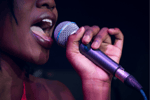Key Takeaways:
- Precision in EQ: Always tweak EQ settings within the context of the full mix to ensure clarity and avoid frequency masking among guitar tracks and other instruments.
- Frequency Management: Utilize high-pass filters and boost selectively in the 3kHz-4kHz range to enhance guitar presence without making the tone harsh or fatiguing.
- Continuous Learning: Explore further tips and techniques through additional resources and consider advanced training at AIMM to refine your music production skills.
Are you struggling with that annoying tinny sound from your electric guitar?
Are you dealing with a boomy, muddy guitar tone in your production?
Are you tired of constantly tweaking without results?
As you know, EQ, or equalization, is a fundamental tool in audio production.
It allows you to boost or cut specific frequency ranges to shape your sound.
Guitars respond distinctly to these adjustments, with specific frequency ranges defining their unique tones.
Below is a rapid-fire guide with 5 EQ tips for mixing your guitar tracks.
These tips will help you achieve the perfect guitar tone, whether you're working with acoustic, distorted, or overdriven guitars.
Achieving the perfect guitar tone is an art form mastered by legendary producers like Bill Szymczyk. He recorded some of the most iconic guitar tracks with The Eagles. This video offers insights into his recording techniques.
Our alumni, like Tosin Abasi, have also mastered these techniques and achieved remarkable career success. Learn more about their journey here.
Understanding the frequency spectrum will allow you to make precise adjustments to make your guitar sound exactly the way you want it.
Table Of Contents
- Less Is More
- Automation Loves EQ
- Think Complimentary
- Save Panning For Later
- Always Tweak In Context
- Bonus: Mic Choices and Placements for Guitar EQ

1. Sometimes Less Actually Is More
Layering can help smooth out an acoustic guitar or electric guitar, allowing it to sit back comfortably in the mix.
However, for maximum prominence, sometimes a single mono guitar track is the best choice.
This is demonstrated by the clarity and power in Eddie Van Halen’s isolated guitar tracks. Listen to how a single, well-EQ’d track can stand out in the mix in this video.
When you focus on a single track, you can better control the individual frequencies and use EQ to carve out a perfect guitar tone.
A high-end EQ plug-in lets you make precise cuts and boosts to address unwanted frequencies or enhance pleasing elements.
Renowned engineer Andrew Scheps exemplifies this approach in his mixes for the Red Hot Chili Peppers on the "Californication" album.
Scheps often utilizes minimal guitar layers, relying on precise EQ adjustments to achieve a clear and powerful guitar presence.
By focusing on fewer layers, he can make more targeted frequency adjustments, ensuring each guitar track stands out with clarity and definition.
For example, Scheps might cut muddiness around 300 Hz while boosting the presence around 3 kHz to enhance the guitar's articulation.
Remember, less is often more.
You can achieve a clearer, more defined sound by simplifying your guitar mix.
This approach is particularly effective with electric guitar tracks. Too many layers can create a frequency glut and muddy the mix.
Check out this live performance by the AIMM house band for a prime example of an outstanding guitar tone.
2. Automation Loves EQ
In audio engineering, automation is far from a "set it and forget it" process.
When mixing guitar tracks—whether electric or acoustic—it's essential to highlight specific sections for greater impact.
Instead of merely increasing the level, consider EQ as a frequency-selective volume control.
Use EQ automation to carve out frequencies where other instruments aren’t dominant and boost the guitar in those ranges.
This approach allows the guitar to cut through the mix without overwhelming it.
High-quality EQ plug-ins or premium hardware units can deliver precise and transparent adjustments.
High-shelving or low-shelving EQ techniques can enhance the guitar tone subtly and effectively.
However, EQ is only one of many tools at your disposal.
Changing the source (guitar), mic, amp, or acoustical environment can achieve remarkable results.
Experimenting with different acoustical environments can also significantly shape the sound.
Techniques like mic placement, selection, and room acoustics adjustments are crucial in crafting a balanced mix.
By boosting the guitar in specific frequency ranges or refining the source itself, you ensure the guitar remains clear and dynamic across the entire frequency spectrum, enhancing your mix's overall balance and depth.
3. Think Complimentary
It's crucial to consider how instruments like guitar, piano, and voice overlap in several frequency ranges when mixing.
To make the voice stand out, slightly boost the highs so it rides above the midrange-heavy piano and guitar.
Decide whether the guitar or piano will dominate the lower midrange and let the other take the upper midrange.
For instance, cutting the piano slightly at 500 Hz and boosting around 1.5 kHz can emphasize the upper mids.
Conversely, boosting the guitar around 400 Hz and cutting at around 2 kHz highlights the lower mids.
This complementary approach creates a more cohesive and professional sound, where each element has its own space and contributes harmoniously to the whole.
Check out this live performance to see how all the instruments work together.
4. Save Panning For Last
Separating instruments by panning might seem like an easy solution.
For example, you could pan the piano left, the guitar right, and the voice center.
Problem solved, right?
Not quite.
While they don’t overlap spatially, their frequencies still do.
If you can mix EQ instruments into their own frequency space in mono, they will become even more distinct when you create a stereo spread.
Focus on carving out frequency ranges for each instrument.
For instance, boost the guitar at 400 Hz and cut at 2 kHz while boosting the piano at 1.5 kHz and cutting at 500 Hz.
This approach ensures each element has its own sonic space, making the mix clearer and more professional.
Once you’ve achieved this balance, panning will enhance the stereo image, making your guitar tracks, piano, and vocals stand out without clashing.
Save panning for last to ensure a well-defined mix element for each instrument.
To hear how EQ and panning work together to create a balanced mix, check out Alex Lifeson’s isolated guitar tracks from Rush.
The separation of frequencies becomes even more distinct when panning is applied correctly, as seen in this video.
For more on advanced panning techniques, check out Warren Huart's video.
In this video, Huart discusses five panning tricks that help create space in a mix and achieve a more immersive musical experience.
His practical tips will guide you in finding the right balance for a professional and clear mix.
For more recording and tracking tips, check out this video with Scott Kieklak, AIMM's Vice President of Student Services.

5. Always Tweak EQ In Context
It’s easy to solo a guitar and make it sound great with warm lows, sizzling highs, and a strong midrange.
However, once you bring in other instruments, the guitar tone can become masked by overlapping frequencies.
Always tweak EQ in the context of the full mix.
Be selective about where you cut and boost based on what the other instruments do.
For instance, use a high-pass filter to remove unnecessary low-end from the guitar or employ an EQ plug-in to fine-tune the guitar sound within the mix.
Remember that if nothing else works, our ears are very sensitive in the 3kHz-4kHz range.
Boosting this range can help any instrument stand out, but be cautious.
Too much boost can make the tone harsh and fatiguing. A little goes a long way.
This approach ensures your guitar tracks remain distinct and clear, complementing other elements without clashing.
Always consider the entire frequency spectrum and use EQ to create a balanced, professional sound.
Bonus: Mic Choices and Placements for Guitar EQ
Understanding mic choices and placements is crucial for achieving the perfect guitar tone, even before you touch an EQ.
Mic choice and placement play a significant role in shaping your guitar’s tone, as demonstrated by Joe Bonamassa in his detailed discussion of his guitar rigs.
Understanding the nuances of mic placement can help you achieve the same rich tones found in this video.
Mic choice and placement significantly impact the frequency content of your recordings, thus affecting the subsequent EQ adjustments and overall sound of your guitar recordings.
You can shape the guitar’s sound at the source by carefully selecting and positioning your microphones.
This ensures that your EQ adjustments are more about refining the tone rather than correcting issues, resulting in a more natural and polished final mix.
Here’s how mic selection and positioning can help you shape your guitar’s EQ:
Mic Choice
- Dynamic Microphones: Dynamic microphones are durable and can handle high sound pressure levels, making them ideal for electric guitars. They typically emphasize the midrange frequencies, which is excellent for capturing an amp's aggressive and punchy tones.
- Condenser Microphones: Condenser microphones are sensitive and have a wide frequency response, capturing more detail and brightness. They are excellent for acoustic guitars, as they can pick up the nuances of the strings and the body of the instrument.
- Ribbon Microphones: Ribbon microphones offer a smooth, high end and warm tone, often featuring a figure-eight polar pattern. They are great for electric and acoustic guitars, providing a vintage, natural sound that enhances the overall mix.
Mic Placement
- Close Miking: Placing the mic 1-3 inches away from the speaker cone for electric guitars or 6-12 inches from the sound hole for acoustic guitars captures a direct, in-your-face sound with plenty of detail and presence. This technique highlights specific frequencies, making EQ adjustments easier.
- Distant Miking: Positioning the mic several feet away from the source captures more room ambiance and a natural blend of frequencies. This approach can add depth to the recording but might require more EQ to manage room resonances.
- Off-Axis Miking: Angling the mic slightly off-axis from the sound source reduces harshness and captures a smoother tone. Off-axis miking can help tame overly bright frequencies before EQ adjustments.
- Dual Miking: Using two microphones, one close and one distant, or one dynamic and one condenser, combines the detail of close miking with the natural ambiance of distant miking. This setup provides a fuller sound and more options for EQ adjustments.
Conclusion
Mastering these essential EQ tips for mixing guitar will help you achieve a balanced and professional mix.
Incorporating high-end EQ plug-ins and premium hardware units allows for precise control.
However, alternative techniques like changing the source instrument, mic, amp, or acoustical environment can also yield remarkable results.
Contact the Atlanta Institute of Music and Media today if you're an experienced musician looking to elevate your skills.
Our programs are designed to help you master advanced music production techniques and achieve your professional goals, equipping you with the knowledge and tools to excel in the industry.
If you enjoyed this article, you should give these a read:
- The Ultimate Guide To Guitar Pedals
- Essential Pieces For A Home Studio
- Become A Better Guitar Player With These Habits













